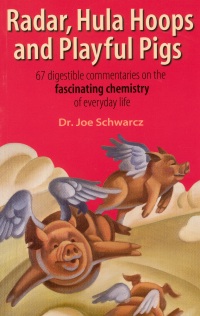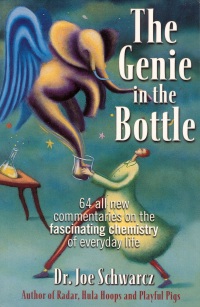| ________________
CM . . .
. Volume X Number 14 . . . . March 12, 2004
I graduated from high school with the normal complement of science courses. Chemistry was an interesting class for those who could memorize well and were good at balancing equations and following the directions for laboratory work. Those who had difficulty thinking about reactions at the particulate level were seated directly in front of the teacher and chalkboard. Each time we wrote a unit test, the seating arrangement would change. You studied in order to be in the back row. It was these students, with desks farthest from the teacher, who had received the highest marks. My post secondary education in science included three courses in chemistry. If Joe Schwarcz had been the instructor of any one of these, my life and the lives of my high school and university friends might have taken different directions. Dr. Schwarcz is a chemist by training and the current director of The McGill Office for Chemistry and Society. He is "Dr. Joe" on the Discovery Channel, a columnist for the Montreal Gazette, and host of a weekly phone-in radio show, The Right Chemistry. He is "enthralled with the magic of chemistry," and this way of thinking, communicated so well in his writing, is infectious. You want to live in the world with his insight of elements and molecules and the consequences of their interactions, and this, as the following excerpt makes clear, is his intent.
The commentaries in Radar, Hula Hoops and Playful Pigs and Genie in the Bottle help to explain the chemistry behind materials and objects we use, wear, or ingest and in many cases have come to depend upon. As the titles suggest, Schwarcz's explanations are told using historical and contemporary incidents and little known details that are made all the more fascinating by their presentation. The first title, as one example, is a consequence of the way in which Schwarcz discusses polyethylene, the plastic material used to make garbage bags, margarine tubs, cling wrap, squeeze bottles, Tupperware, Frisbees, Barbie dolls, hula hoops, and artificial hip joints. It was "discovered" in 1933 by two organic chemists working on chemical reactions at high pressures for Imperial Chemical Industries in England. Ethylene had been mixed with another reagent in a pressurized cylinder. The result was a white powder or "small molecules of ethylene that had joined together to form giant molecules of polyethylene" (p. 55). When the techniques for mass production had been worked out, the material was used as an insulator for underwater cables. During World War II, polyethylene made it possible for the Allies to install radar equipment in airplanes of the Royal Air Force; a technology that Schwarcz suggests helped to turn the tide of battle. How do pigs fit into a story of polyethylene? It seems that confined pigs nibble on one another's tails causing infection. When balls of high-density polyethylene are put into pigpens, the pigs start pushing the balls around. They forget their pen mates' tails and play. This bouncy exercise has the added advantage of promoting weight gain and preventing the pork from becoming watery. In addition to incorporating brief histories of the chemicals described, albeit non-referenced, there are projections of products yet to come and Schwarcz's informed advice. We may, for example, be applying sunscreens that contain enzymes capable of repairing damaged DNA molecules, wearing silver-coated fibres to control not only foot odour but also underarm odour, buying undergarments impregnated with aphrodisiacs, and swallowing cancer-fighting pills based on pectin. Until that day, he suggests that we eat a variety of fruits and vegetables, dress salads with flax oil, aim to daily drink eight glasses of water, look for shade when your shadow is shorter than your actual height, avoid willow extracts and take 40 to 80 mg of aspirin a day for cardio-protective effects, disclose to your physician all medications being taken including herbal preparations, never mix bleach and ammonia or bleach and toilet bowl cleaners containing sodium hydrogen sulfate, wash skunk-sprayed pets with one litre of 3% hydrogen peroxide, one-quarter cup baking soda, and one teaspoon of liquid dishwashing detergent, and examine any new finding with scepticism. This last point is well addressed in Radar, Hula Hoops and Playful Pigs and Genie in the Bottle. Schwarcz's aim is scientific literacy as much as it is to open up the remarkable world of chemistry to readers. He is determined to clarify the artificial distinction between natural and synthetic chemicals and to dispel the belief held by many that chemicals are dangerous things. Chemicals are the building blocks of all matter, whether derivatives of plants and animals or synthesized in laboratories. Schwarcz writes: "...they are not good or bad. They are just things. It is up to us to decide how to use them. The same chemical that can kill can also cure." (1999, p. 16.) In this light, the titles and cover illustrations could not have been more appropriate. They will appeal as much to the lay person as to scientists, educators of science teachers, and science teachers themselves. All will benefit from reading Schwarcz's writing, but it is the reader who may have been seated in the front row of my high school chemistry class or who "links the word chemical with pejorative adjectives" that has the most to discover. Highly Recommended. Barbara McMillan is a professor of early years science education in the Faculty of Education, the University of Manitoba.
To comment
on this title or this review, send mail to cm@umanitoba.ca.
Copyright © the Manitoba Library Association. Reproduction for personal
use is permitted only if this copyright notice is maintained. Any
other reproduction is prohibited without permission.
NEXT REVIEW |TABLE OF CONTENTS FOR THIS ISSUE - March 12, 2004. AUTHORS | TITLES | MEDIA REVIEWS | PROFILES | BACK ISSUES | SEARCH | CMARCHIVE | HOME |

